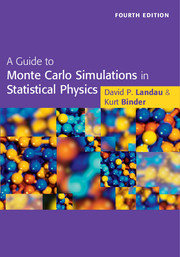Book contents
- Frontmatter
- Contents
- Preface
- 1 Introduction
- 2 Some necessary background
- 3 Simple sampling Monte Carlo methods
- 4 Importance sampling Monte Carlo methods
- 5 More on importance sampling Monte Carlo methods for lattice systems
- 6 Off-lattice models
- 7 Reweighting methods
- 8 Quantum Monte Carlo methods
- 9 Monte Carlo renormalization group methods
- 10 Non-equilibrium and irreversible processes
- 11 Lattice gauge models: a brief introduction
- 12 A brief review of other methods of computer simulation
- 13 Monte Carlo simulations at the periphery of physics and beyond
- 14 Monte Carlo studies of biological molecules
- 15 Outlook
- Appendix: Listing of programs mentioned in the text
- Index
- References
1 - Introduction
Published online by Cambridge University Press: 05 November 2014
- Frontmatter
- Contents
- Preface
- 1 Introduction
- 2 Some necessary background
- 3 Simple sampling Monte Carlo methods
- 4 Importance sampling Monte Carlo methods
- 5 More on importance sampling Monte Carlo methods for lattice systems
- 6 Off-lattice models
- 7 Reweighting methods
- 8 Quantum Monte Carlo methods
- 9 Monte Carlo renormalization group methods
- 10 Non-equilibrium and irreversible processes
- 11 Lattice gauge models: a brief introduction
- 12 A brief review of other methods of computer simulation
- 13 Monte Carlo simulations at the periphery of physics and beyond
- 14 Monte Carlo studies of biological molecules
- 15 Outlook
- Appendix: Listing of programs mentioned in the text
- Index
- References
Summary
What is a Monte Carlo simulation?
In a Monte Carlo simulation we attempt to follow the ‘time dependence’ of a model for which change, or growth, does not proceed in some rigorously predefined fashion (e.g. according to Newton's equations of motion) but rather in a stochastic manner which depends on a sequence of random numbers which is generated during the simulation. With a second, different sequence of random numbers the simulation will not give identical results but will yield values which agree with those obtained from the first sequence to within some ‘statistical error’. A very large number of different problems fall into this category: in percolation an empty lattice is gradually filled with particles by placing a particle on the lattice randomly with each ‘tick of the clock’. Lots of questions may then be asked about the resulting ‘clusters’ which are formed of neighboring occupied sites. Particular attention has been paid to the determination of the ‘percolation threshold’, i.e. the critical concentration of occupied sites for which an ‘infinite percolating cluster’ first appears. A percolating cluster is one which reaches from one boundary of a (macroscopic) system to the opposite one. The properties of such objects are of interest in the context of diverse physical problems such as conductivity of random mixtures, flow through porous rocks, behavior of dilute magnets, etc. Another example is diffusion limited aggregation (DLA) where a particle executes a random walk in space, taking one step at each time interval, until it encounters a ‘seed’ mass and sticks to it. The growth of this mass may then be studied as many random walkers are turned loose. The ‘fractal’ properties of the resulting object are of real interest, and while there is no accepted analytical theory of DLA to date, computer simulation is the method of choice. In fact, the phenomenon of DLA was first discovered by Monte Carlo simulation.
Information
- Type
- Chapter
- Information
- Publisher: Cambridge University PressPrint publication year: 2014
